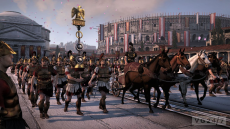
Historians often consider a century as the 100 years it literally is, in this case 100-200 AD, but in analysing the second century AD in Rome as a ‘Golden Age’ it is more useful to consider the ‘happy period of more than four score years… of Nerva, Trajan, Hadrian, and the two Antonines’. Nerva ruled for less than two years from 96-98 AD before he died of natural causes and his short reign is frequently overlooked as ‘a pale intermission’ between the assassination of Domitian and the prosperous military career of Emperor Trajan. However, Nerva’s short reign immediately began to reverse the mistakes of Domition, melting down gold and silver images of him for coin, distributing land and money to the poor and inviting the return to Rome of those exiled under Domition. Perhaps most importantly is the way in which Nerva received power and passed it on that set a precedent for the beginning of the ‘Golden Age’. Nerva had served the cursus honorum correctly and now entitled with the position of Emperor worked in co-operation with the Senate still so was a model of a fair Roman leader and the polar opposite of Domition. Although the circumstances of Trajan’s adoption are unclear, by doing so Nerva created the Nerva-Antonine Dynasty and ensured a smooth transition of power without civil war, again setting the precedent for a prosperous century to come. With Trajan’s reign the much neglected Roman Army, disused for decades and then misused in Britain, finally ‘had a military emperor at their head.’As Gibbon notes glory and fame is bestowed upon exalted generals rather than politicians in the Ancient World and so Trajan was the perfect choice in 98 AD to restore the military glory of Rome going into the 2nd Century.
Here again we must consider what constitutes a ‘Golden Age’ in the Roman world; assuming it to be riches, military glory and political and social stability then Trajan’s reign does just that. His first conquest was that of the Dacians who Gibbons tells us had insulted Rome during Domitian’s reign.The details of the war are somewhat irrelevant but through war Rome receives glory, it receives money to boost the economy, it receives slaves to both bolster the economy and maintain the social structure of households and work and finally it gains more land. Ultimately Rome needed war and it needed slaves, they ‘were symbols of Rome’s power’. So one can ascertain that through war Trajan had reignited the flame of Roman power, but then this would make the lives and campaigns of Pompey and Caesar in Spain and Gaul a ‘Golden Age’ for Rome yet the first century BC is regarded negatively as the collapse of Rome’s Oligarchical system. It must be more than just success in war then that constitutes a ‘Golden Age’ so looking further Julian Bennett notes that Trajan played an ‘active and diligent part in the formulation and administration of justice.’ Indeed in a truly Golden Age for the Roman people it would not be just military conquests and riches for the soldiers but social justice and stability also. Gibbon seems to accredit the golden age notion to the consistency and diversity of Roman success in the second century and ease of succession between Emperors, it is noteworthy that this period of the five good emperors all died naturally which in ancient history is rare for an entire dynasty (excluding Commodus), especially in Rome. Perhaps most impressive is not just the military campaigns of Rome or the social stability in this period but that they managed to maintain the already incredibly expansive borders of the Empire. Such archaeological works as Trajan’s Column and Hadrian’s Wall are testimony to that. Everything about Trajan’s column is impressive, from the organisation of its construction to the depictions of roman victory over the Dacians inscribed upon it, and perhaps that is what constitutes this ‘Golden Age’; not one sole reason, not the military glory in Dacia, not revenge on the Parthians who Rome had been forced to pay for their Eagles and who Trajan crushed, but a combination of all these factors within the Roman system working in perfect harmony together.

0 Comment:
Be the first one to comment on this article.